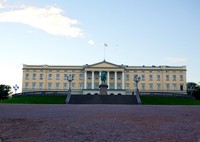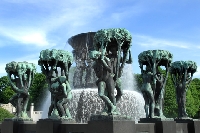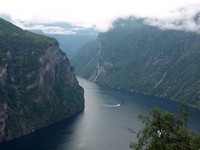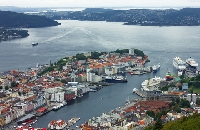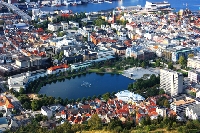by country
A grand tour of Fjord Norway
Day 1
Oslo
Arrival at the airport and transfer to hotel.
Day 2
Oslo – Lillehammer (190km/2h45min)
Start the day with a stroll up Karl Johans gate, from Parliament to the Royal Palace. If you are an art lover, continue walking to the Vigeland Park, with its amazing collection of granite and bronze sculptures that tells the story of the human condition – and you must surely also visit the museum dedicated to the master expressionist Edvard Munch. Another popular attraction is the new spectacular opera house, with its fabulous location by the sea shore . On the Bygdøy peninsula there are cultural treasures such as the Viking Ship Museum, the Norwegian Museum of Cultural History, and Thor Heyerdahl’s Kon-Tiki Museum. Continue to the town of Lillehammer. Here you can still see the stadiums built for the 1994 Winter Olympics. Overnight.
Day 3
Lillehammer – Åndalsnes (263km/4h20min)
Today continue to the village ofÅndalsnes with its surrounding mountains and fjords that are among the greatest in Norway. Have a trip to the Trollstigen, a mountain road climbing the pass between Isterdalen valley in the North and Valldal valley in the South. This road is the major attraction in this area and one of the most visited destinations in Norway. See also The Trollveggen, Europe's highest vertical and overhanging rocks. And the Waterfalls at Monge, Verma and Sletta. Overnight.
Day 4
Åndalsnes – Molde (60 km/2) 1 ferry
Continue by ferry to Sølsnes. A subsea tunnel leads you on the final stretch into the town of Molde. Molde is legendary for its summer jazz festival. Pay a visit to Romsdal Museum, an excellent folk museum. Molde is also known for its beautiful panorama, which includes 222 mountain peaks. A few kilometres to the south of Molde is Hjertøya, less than 10 minutes away by boat. This island is known for its fishing village and open air museum, with a collection of buildings and boats and fishing equipment that gives an authentic feel of the coastal culture. Return to Molde for overnight.
Day 5
Molde – Kristiansund (100km/2h)
The journey to your next destination is a real treat. A subsea tunnel takes you under the fjord to Kristiansund! which is one of Norway’s best-known towns. It is built on four islands. During World War II, the town was nearly wiped from the map by German bombs and a subsequent fire. Almost 900 houses were destroyed. Some of the older houses can be seen on the lower part of Innlandet. Today the town of Kristiansund is a successful example of post-war reconstruction. The revised city plan is characterised by beautiful parks and an orderly grid with long, straight streets. Perhaps the town’s most characteristic traits are its polychrome appearance and the pulsating heart of Kristiansund as well as the charming harbour.
Day 6
Kristiansund – Ålesund (145km,1ferry/4 hours)
Continue to Hjelset crossing the fjord by ferry to Vestnes. Carry on to Ålesund. It has perhaps the most coherent concentration of Art Nouveau architecture in the world. The reason is the fire that devastated the town on a winter night in 1904, leaving ten thousand people homeless and 800 buildings in ashes. Architects and builders came quickly from all over Norway to help rebuild Ålesund. Although there was no time for detailed city planning, the guidelines laid down, and the spirit of the times, lent Ålesund a new face, Art Nouveau with a distinctly Norwegian character. Visitors who wish historical and artistic insight are urged to join a guided city walk, and should in addition experience the “Time Machine” at the Art Nouveau Centre. Later climb the stairs of Aksla, the 130 metre high mountain in the centre of town. Overnight.
Day 7
Ålesund – Geiranger (110km,1ferry,3h)
Drive to Sjøholt. Take the ferry to Eidsdal, and then follow the road enjoying the famous region of Geiranger. From the spectacular viewpoint along Ørnevegen (the eagle’s road), you can appreciate why the Geirangerfjord is listed as a UNESCO World Heritage Site. A few years ago it topped National Geographic Traveller magazine’s poll of experts, along with the Nærøyfjord, as the best-preserved UNESCO attraction of them all. Another fine view is at Flydalsjuvet, a rocky outcrop above the village of Geiranger. You can visit Geiranger Fjord Centre to learn more about the history and culture of the people who live along the fjord. You have the opportunity to take mountain walks on the well-marked trails, or perhaps a kayak excursion on the fjord. Ever since the first foreign visitors came here in the middle of the 19th century, the Geirangerfjord has attracted kings and queens, emperors and millionaires, and ordinary people who recognise natural beauty when they see it. Overnight at Geiranger.
Day 8
Geiranger – Stryn – Sogndal (190km/1ferry/4h)
Take the ferry from Geiranger to Hellesylt. You will have an hour to enjoy the tall mountains and majestic waterfalls such as De Syv Søstre, Brudesløret and Friaren. From Hellesylt continue to Sogndal, perhaps stopping at the Norwegian Glacier Museum in Fjærland and seeing Bøyabreen, another arm of Jostedalsbreen. Sogndal is the meeting place of fjords, mountains and glaciers; this is also a premier fruit-growing region. Another attraction not to be missed is Urnes stave church – yet another UNESCO World Heritage Site. Overnight in Sogndal.
Day 9
Sogndal – Fodnes (22km/40min) – Voss (116km/2h20min) 1 ferry
Cross the fjord to Fodnes. Before taking the ferry, take the opportunity to visit Kaupanger stave church. A tunnel from Fodnes takes you to Lærdal. Here, the old village centre is wonderfully preserved, with a charm all its own. One of Norway’s best-known salmon rivers runs right through the village. A highly recommended attraction is the Norwegian Wild Salmon Centre. As you continue toward Bergen you have an option. You can travel the world’s longest road tunnel, which connects Lærdal to Aurland (24.5 km), or you can drive along Aurlandsvegen (the Aurland road, also referred to as the snow road), and be rewarded by spectacular views of the Aurlandsfjord. From here you have the opportunity to take a fjord cruise that includes the Nærøyfjord, the narrowest fjord in the world and yet another UNESCO World Heritage attraction. When you disembark in the innermost village of Gudvangen, there is no need to hurry. Take your time driving up the beautiful river valley, between towering mountains. The road continues to Voss, an inland town seeped in cultural traditions. Take a pause from your travels at Voss Folk Museum. Voss is also famous for its annual Extreme Sport Festival. Overnight in Voss.
Day 10
Voss
Transfer to the airport fordeparture

